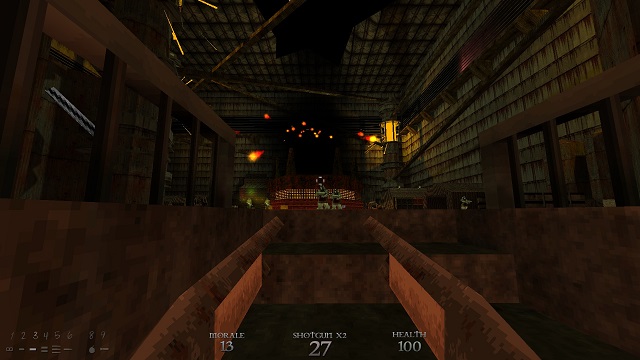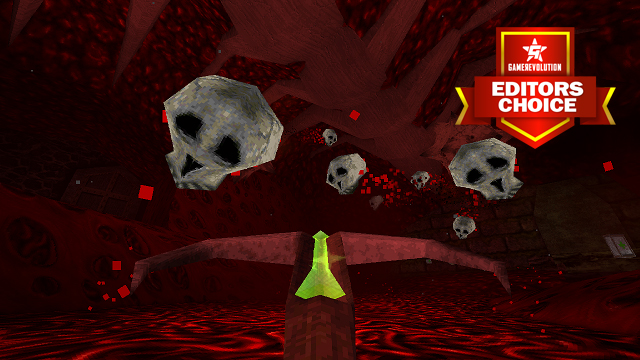Like the upcoming Backstreet Boys reunion tour, it’s easy to dismiss the recent retro first-person shooter trend as just another side effect of ’90s nostalgia. While there’s no denying that this is partially true, this style of high-speed shooter never truly went away, serving its specific niche while Call of Duty hit the mass market. For every Serious Sam in the mainstream, there were countless mods and fan projects keeping the old school flames alive, waiting for the right moment. Thanks to Early Access, we know that the time is now. If 2019 is going to be the ultimate retro first-person shooter resurgence, DUSK is a fantastic game to lead that charge.
Years in the making, Dusk doesn’t ever rest on its laurels. In a year starved for first-person shooter campaigns, a high-speed chase to the depths and back might have been enough. However, there are countless examples in Dusk‘s three episodes of it going above and beyond. Levels have intricate layouts that reveal themselves as you play. Secrets dot the landscape, rewarding exploration and quick thinking. Mechanics present themselves without explanation, forcing you to teach yourself the ropes before you start backflipping, sliding, and altering gravity in your truly damned voyage.
Dusk Review – Bible Black

You start off Dusk chained in the basement of a farmhouse. Masked men with chainsaws march towards you with ill intent. Your only weapon is a pair of sickles that you use to slash your way out of your bondage and through a whole host of homicidal religious cultists. While the traditional narrative of Dusk lacks originality, it makes up for it in its mood. Each new level reinforces that atmosphere at every turn through grimy heavy metal and its dirty visual style. The deep voice of the big bad taunts you as you go from stage to stage, as do the bloody scrawls of those that came before. The unearthly screams of each opponent echo through the halls, encouraging you to run like hell.
This turns out to be good advice. Dusk doesn’t pull any punches with its lightning fast gameplay. While you may find yourself cornered on occasion, you have a ridiculous freedom of movement that lets you pull off superhuman stunts. Generous air control compliments your floaty jump, letting you pinpoint where you’ll land at all times. Certain levels have jump pads, giving you a bird’s eye view of the action and letting your rain fire from above. Some weapons (like the glowing crossbow) even propel you backward, letting you gain momentum while airborne, reaching otherwise unattainable heights. And all of them combine to make combat a quick, constantly engaging cycle of death and carnage that’s faithful to the era and still a blast nowadays.
Dusk knows where these movement options will lead you. It’s always one step ahead of you no matter what stupid tricks you throw at it. Reach the roof of a tall building, you’ll find rocket ammo. Squeeze your way through a window, there’s a button that opens a hidden passage. Run towards an open air vent and hit the duck button to slide into a secret tunnel. Later levels even have you flipping the landscape and dashing across the ceiling to get where you’re going. Dusk always rewards you for messing around, even if that reward is a punishing combat challenge.
Of course, you don’t have to go out of your way to find challenge in Dusk. This is an experience that takes its cues from the days when you didn’t need an achievement to feel like you’ve achieved something. Every room will have you reaching to the save menu, relieved that you never have to fight that specific combination of enemies again. That does mean that manual saves are the order of the day, which can be frustrating unless you can mentally acclimate to its ’90s-era rules.
Dusk Review – Don’t Talk to Strangers

There are three episodes made up of ten levels each. Over the course of those stages, you’ll face a handful of bosses. You can tell they’re coming up if you wander into a room with an ammo backpack and enough room to circle strafe. This is probably where Dusk shines the least, as there’s simply not much you can do with this type of encounter. You’ve got huge creatures that take an entire arsenal’s worth of shots to conquer. Just avoid their projectiles and grind to victory. At least most bosses are unique creatures rather than plus-sized enemies, and each one has a few surprises to throw at you, which makes them good but not great.
What is great about Dusk is its arsenal of weapons. While there aren’t any standout, oddball Needler-type guns here, you’ve got unique versions of everything you’d want out of this style of shooter. The hunting rifle is a particular standout since it’s a sniper weapon that recognizes that no one wants to snipe in a Doom game. Instead, it just offers a generous zoom and a powerful single shot, operating as a fast loading blunderbuss. Dusk‘s super shotgun also must be mentioned as it’s a boomstick that’s just as satisfying as anything produced by id Software due to its beefy sound effects, the way the shells shoot out, and how it makes most enemies crumple. Its arsenal combines with the nimble movement abilities and ensures that gunplay is always frenetic and explosive.
There’s also more to play after you finish the campaign in case you want to stay in Dusk‘s world, which is understandable given how solid the shooting is. There’s a deathmatch client, which is another standard from that era of shooters. Operating as a separate executable, DUSKWORLD does what it needs to with eight maps ripped from the campaign. It’s pretty extraneous but works as a bonus for diehard fans. The game’s Endless options are more fun and basically Devil Daggers in Dusk‘s world since it keeps throwing enemies at you until you die. It has three stages (one for each episode of the main game) and serves as a great way to keep playing once you’ve wrung everything out of the campaign and just want more.
Dusk Review – We Rock

If there’s anything that’s off-putting about Dusk, it’s the visual style. This is a game that authentically replicates the look of games like Quake, complete with chunky polygonal models. This aesthetic makes it easier to focus on the pristine gameplay. However, it does feel like the one place in Dusk that is nostalgic for nostalgia’s sake. Nowhere in the campaign does the curtain peel back and take advantage of the current tech. For as forward-thinking as the gameplay additions are, its archaic visual style just feels like a missed opportunity.
Still, if you like first-person shooters in any way, you’ll be more than satisfied with Dusk. While you can get through all three episodes in just a few sittings, each level demands to be stared at for far longer. I was constantly grinning from ear to ear as I discovered new shortcuts and spent what felt like hours hiding out in corners, trying to lure enemies into fighting each other. Even while calling back to a previous era, Dusk adds on top of those legacies. This is retro first-person shooter perfection, the next evolution in a genre once frozen in time. Long may it reign once again.
Dusk was reviewed on PC via Steam with a code provided by the developer.







